

Stress continues to be a universal issue and workplace wellness is on the decline. We will be looking at some of the contributing factors to stress among working adults especially in workplaces; current coping mechanisms available and how it can be improved to better deal with the stress perceived by this group of people in their work places.
360Survey Report. 2019 Cigna 360 Well-Being Survey Well & Beyond. Work-related stress. Symptoms of work-related stress Work-related stress is a growing problem around the world that affects not only the health and well-being of employees, but also the productivity of organisations.
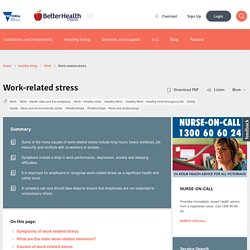
Work-related stress arises where work demands of various types and combinations exceed the person’s capacity and capability to cope. Work-related stress is the second most common compensated illness/injury in Australia, after musculoskeletal disorders. Work-related stress can be caused by various events. For example, a person might feel under pressure if the demands of their job (such as hours or responsibilities) are greater than they can comfortably manage. In Australian, more than $133.9 million was paid in benefits to workers who had made claims related to workplace stress during the 2004/2005 tax year. Main causes of workplace stress. Stress graph hse stats. UK labour force survey. Employee Burnout Is a Problem with the Company, Not the Person.
Executive Summary Executives tend to think of employee burnout as an individual issue rather than a broader organizational challenge.

That’s a mistake. The psychological and physical problems of burned-out employees, which cost an estimated $125 billion to $190 billion a year in healthcare spending in the US, are just the most obvious impacts. The true cost to business can be far greater, thanks to low productivity across organizations, high turnover and the loss of the most capable talent. Leaders need to own up to their role in creating the workplace stress that leads to burnout — heavy workloads, job insecurity, and frustrating work routines that include too many meetings and far too little time for creative work.
Employee burnout is a common phenomenon, but it is one that companies tend to treat as a talent management or personal issue rather than a broader organizational challenge. Excessive collaboration. Unreallistic expectations on employees driven by a digital work place. A Career Development Support System. Supervisors have a large effect on employee perceptions of development opportunities.
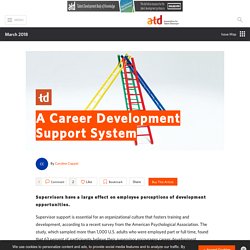
Supervisor support is essential for an organizational culture that fosters training and development, according to a recent survey from the American Psychological Association. The study, which sampled more than 1,000 U.S. adults who were employed part or full time, found that 63 percent of participants believe their supervisor encourages career development. Advertisement That support, the study found, helps reinforce the training and development function's mission. Lack of clear career development and training scheme as a contributor. Lack of support from bosses causes employee disengagement. Lack of recognition as a contributor. Workplace Bullying: Causes, Effects, and Prevention.
Bullying is a form of aggression that can occur anywhere.
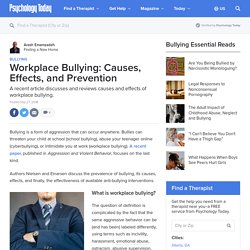
Bullies can threaten your child at school (school bullying), abuse your teenager online (cyberbullying), or intimidate you at work (workplace bullying). Work place bullying as a main contributor. The globalisation of work - and people. What is fundamentally transforming work is extraordinary connectivity.
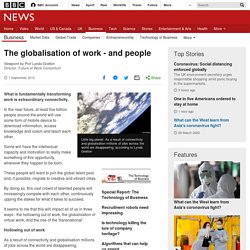
In the near future, at least five billion people around the world will use some form of mobile device to download information, access knowledge and coach and teach each other. Some will have the intellectual capacity and motivation to really make something of this opportunity, wherever they happen to be born. These people will want to join the global talent pool and, if possible, migrate to creative and vibrant cities.
By doing so, this vast crowd of talented people will increasingly compete with each other, continuously upping the stakes for what it takes to succeed. Globalisation as a cause for increased stress level. Workplace stress. Signs of stress. 360Survey Report. Bridging the gap in organisation support and wellness programs. Employee Workload Stress. Downsizing businesses, fears of job security and a wobbly economy mean heavy workloads on staff have become accepted as normal.
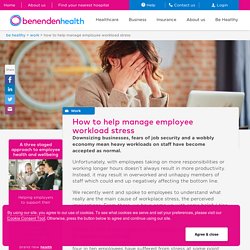
Unfortunately, with employees taking on more responsibilities or working longer hours doesn’t always result in more productivity. Instead, it may result in overworked and unhappy members of staff which could end up negatively affecting the bottom line. We recently went and spoke to employees to understand what really are the main cause of workplace stress, the perceived implications. From there, we have come up with some helpful tips how you can support reducing your employee's stress levels through workload management. What is the main cause of workplace stress? Our report, Mental Health in the Workplace, found that more than four in ten employees have suffered from stress at some point during their career due to their workload. 1.
Download your free health and wellbeing guide today! Download here Why are companies increasing staff workloads? 1. 2. 3. 4. 5. 6. Regulating employee's increasing workload and relationship at work. 12 Ways To Eliminate Stress At Work. The average business professional has 30 to 100 projects on their plate.

Modern workers are interrupted seven times an hour and distracted up to 2.1 hours a day. And four out of 10 people working at large companies are experiencing a major corporate restructuring, and therefore facing uncertainly about their futures. This may be why more than 40% of adults say they lie awake at night plagued by the stressful events of the day. Singaporeans are among the most stressed at work, globally. Singaporeans are among the most stressed at work, globally, the 2019 Cigna 360 Well-Being Survey – Well and Beyond has revealed.
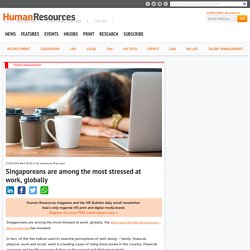
In fact, of the five indices used to examine perceptions of well-being – family, financial, physical, work and social, work is a leading cause of rising stress levels in the country. Financial concerns and health concerns follow as the second and third respectively. More importantly, the ‘always on’ corporate culture that is prevalent in Singapore is another contributor of stress, particularly among women – 71% feel they work in such a culture, as compared to 66% of men.
On this, April Chang, Chief Executive Officer, Cigna Singapore, said: “A busy work life, combined with an ‘always on’ culture, is impacting the physical and social well-being of Singaporeans. “The stigma of seeking help for mental well-being may also prevent many from pursuing professional help.” ALSO READ: Mental wellness at the workplace: It goes beyond the occasional day-off The global snapshot.
TODAYonline. SINGAPORE — Singaporeans are not only sleep deprived, but they are also among the most stressed at work globally, according to a survey by health service company Cigna released on Tuesday (Mar 26).
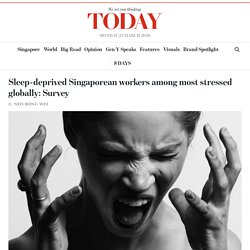
Nearly 92 per cent of Singaporeans surveyed were stressed from work, which was higher than the global average of 84 per cent. Of this group, 13 per cent said that the stress they faced was unmanageable. Singaporeans’ physical wellness index also dipped by 4.4 percentage points from last year, which the survey attributed to an increase in sleepless nights. Of the 23 markets surveyed, Singapore had the fifth lowest wellness index, which was measured across five key indices — family, financial, physical, social and work. Singapore fell by a place from last year as its wellness index went down by 1.7 points to 57.8. The survey collated about 13,200 responses from over 24 countries, with a sample of 502 respondents in Singapore.
Read also “Vulnerability will make it seem that you are not as competent. Local context.